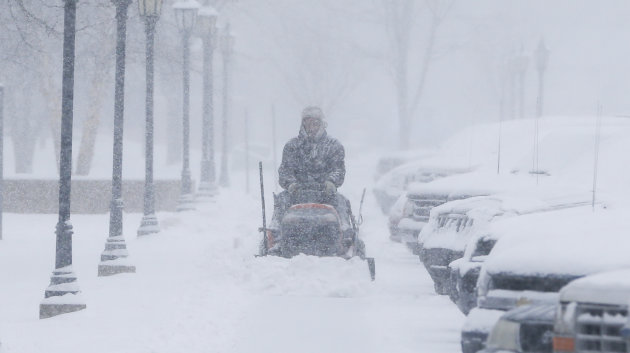ST. LOUIS (AP) —
Hundreds of snow plows and salt spreaders took to the highways of the
nation's heartland Wednesday, preparing for a winter storm that could dump up to a foot of snow in some areas and bring dangerous freezing rain and sleet to others.
Winter storm warnings were issued from Colorado through Illinois. By midday Wednesday, heavy snow was already falling in Colorado and western Kansas.
National Weather Service meteorologist Jayson Gosselin
said parts of Colorado, Kansas and northern Missouri could get 10 to 12
inches of snow. Dodge City, Kan., was bracing for up to 16 inches of
snow. Further south, freezing rain and sleet could make driving
treacherous.
Officials feared the winter storm would be the worst in the Midwest
since the Groundhog Day blizzard in 2011. A two-day storm that began
Feb. 1, 2011, was blamed in about two dozen deaths and left hundreds of
thousands without power, some for several days. At its peak, the storm
created white-out conditions so intense that Interstate 70 was shut down
across the entire state of Missouri.
"We're not going to see that type of storm, but it's certainly the most impactful in the last two winters," said Gosselin, who works in suburban St. Louis.
Tim Chojnacki, spokesman for the Missouri Department of Transportation,
said it planned to have salt trucks on the roads before the storm
arrived in the Show-Me State in hopes that the precipitation would
largely melt upon impact.
Gosselin said sleet and freezing rain could make areas like St.
Louis, southern Missouri and parts of Texas, Oklahoma and Arkansas more
dangerous than those with heavy snowfalls. Ice accumulations could reach
a half-inch in some places."Sleet is no fun to drive on," Gosselin said. "Especially if you get a couple of inches, which could happen. It doesn't melt, and it's very heavy to move. It's difficult to shovel, you can't really plow it and the chemicals don't work as well."
Much of Kansas was expected to get up to a foot of snow, which many rural residents welcomed after nearly a year of drought.
Jerry and Diane McReynolds spent part of Wednesday putting out more hay and straw for newborn calves at their farm near Woodston in north central Kansas. The storm made extra work, but Diane McReynolds said it would help their winter wheat, pastures and dried-up ponds.
"In the city you hear they don't want the snow and that sort of thing, and I am thinking, 'Yes, we do,' and they don't realize that we need it," she said. "We have to have it or their food cost in the grocery store is going to go very high. We have to have this. We pray a lot for it."
Meanwhile, a separate snow storm caught many drivers by surprise in California, leaving hundreds stranded on mountain highways. A 35-mile stretch of Highway 58 between Mojave and Bakersfield was closed Wednesday, and several school districts closed. No injuries were reported.
Schools also were closed in northern Arizona and Colorado with snow there. Mindy Crane, a spokeswoman for the Colorado Department of Transportation, said hundreds of plows had been deployed for what was expected to be one of the most significant snow storms of the season.
Just the threat of snow had a big impact in Nebraska, where lawmakers cancelled Thursday afternoon committee hearings and University of Nebraska officials moved a Big 10 men's basketball game against Iowa from Thursday to Saturday.
Gosselin said precipitation is
generally expected to drop off as the storm makes its way east. Chicago
and parts of Indiana, he said, could get about 2 inches of snow and some
sleet.



